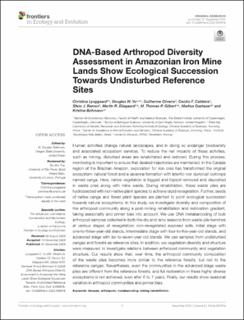| dc.contributor.author | Lynggaard, Christina | |
| dc.contributor.author | Yu, Douglas W. | |
| dc.contributor.author | Oliveira, Guilherme | |
| dc.contributor.author | Caldeira, Cecilio F. | |
| dc.contributor.author | Ramos, Silvio J. | |
| dc.contributor.author | Ellegaard, Martin | |
| dc.contributor.author | Gilbert, Marcus Thomas Pius | |
| dc.contributor.author | Gastauer, Markus | |
| dc.contributor.author | Bohmann, Kristine | |
| dc.date.accessioned | 2021-02-01T14:44:51Z | |
| dc.date.available | 2021-02-01T14:44:51Z | |
| dc.date.created | 2021-01-07T13:06:07Z | |
| dc.date.issued | 2020 | |
| dc.identifier.citation | Frontiers in Ecology and Evolution. 2020, 8 . | en_US |
| dc.identifier.issn | 2296-701X | |
| dc.identifier.uri | https://hdl.handle.net/11250/2725648 | |
| dc.description.abstract | Human activities change natural landscapes, and in doing so endanger biodiversity and associated ecosystem services. To reduce the net impacts of these activities, such as mining, disturbed areas are rehabilitated and restored. During this process, monitoring is important to ensure that desired trajectories are maintained. In the Carajás region of the Brazilian Amazon, exploration for iron ores has transformed the original ecosystem; natural forest and a savanna formation with lateritic iron duricrust outcrops named canga. Here, native vegetation is logged and topsoil removed and deposited in waste piles along with mine waste. During rehabilitation, these waste piles are hydroseeded with non-native plant species to achieve rapid revegetation. Further, seeds of native canga and forest plant species are planted to point ecological succession towards natural ecosystems. In this study, we investigate diversity and composition of the arthropod community along a post-mining rehabilitation and restoration gradient, taking seasonality and primer bias into account. We use DNA metabarcoding of bulk arthropod samples collected in both the dry and rainy seasons from waste-pile benches at various stages of revegetation: non-revegetated exposed soils, initial stage with one-to-three-year-old stands, intermediate stage with four-to-five-year-old stands, and advanced stage with six-to-seven-year-old stands. We use samples from undisturbed cangas and forests as reference sites. In addition, we vegetation diversity and structure were measured to investigate relations between arthropod community and vegetation structure. Our results show that, over time, the arthropod community composition of the waste piles becomes more similar to the reference forests, but not to the reference cangas. Nevertheless, even the communities in the advanced-stage waste piles are different from the reference forests, and full restoration in these highly diverse ecosystems is not achieved, even after 6 to 7 years. Finally, our results show seasonal variation in arthropod communities and primer bias. | en_US |
| dc.language.iso | eng | en_US |
| dc.publisher | Frontiers Media | en_US |
| dc.rights | Navngivelse 4.0 Internasjonal | * |
| dc.rights.uri | http://creativecommons.org/licenses/by/4.0/deed.no | * |
| dc.title | DNA-Based Arthropod Diversity Assessment in Amazonian Iron Mine Lands Show Ecological Succession Towards Undisturbed Reference Sites | en_US |
| dc.type | Peer reviewed | en_US |
| dc.type | Journal article | en_US |
| dc.description.version | publishedVersion | en_US |
| dc.source.pagenumber | 15 | en_US |
| dc.source.volume | 8 | en_US |
| dc.source.journal | Frontiers in Ecology and Evolution | en_US |
| dc.identifier.doi | https://doi.org/10.3389/fevo.2020.590976 | |
| dc.identifier.cristin | 1867045 | |
| dc.description.localcode | Copyright © 2020 Lynggaard, Yu, Oliveira, Caldeira, Ramos, Ellegaard, Gilbert, Gastauer and Bohmann. This is an open-access article distributed under the terms of the Creative Commons Attribution License (CC BY). The use, distribution or reproduction in other forums is permitted, provided the original author(s) and the copyright owner(s) are credited and that the original publication in this journal is cited, in accordance with accepted academic practice. No use, distribution or reproduction is permitted which does not comply with these terms. | en_US |
| cristin.ispublished | true | |
| cristin.fulltext | original | |
| cristin.qualitycode | 1 | |

